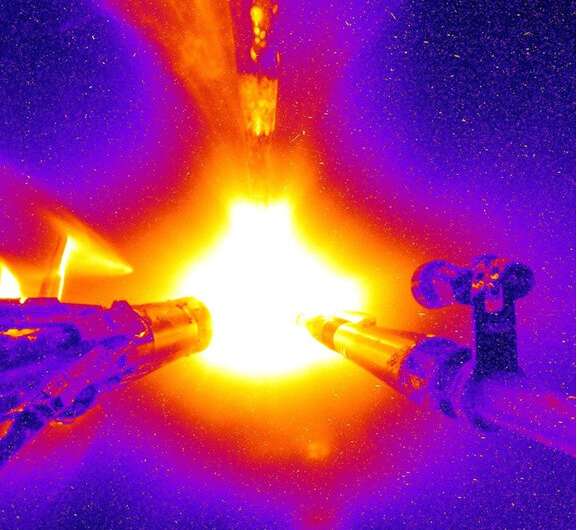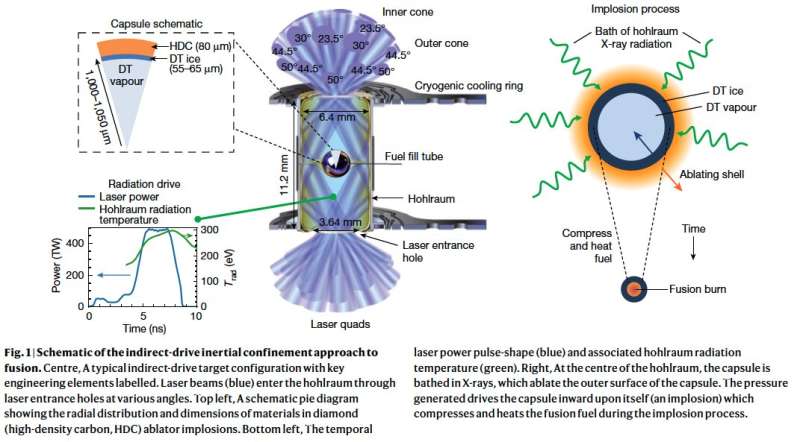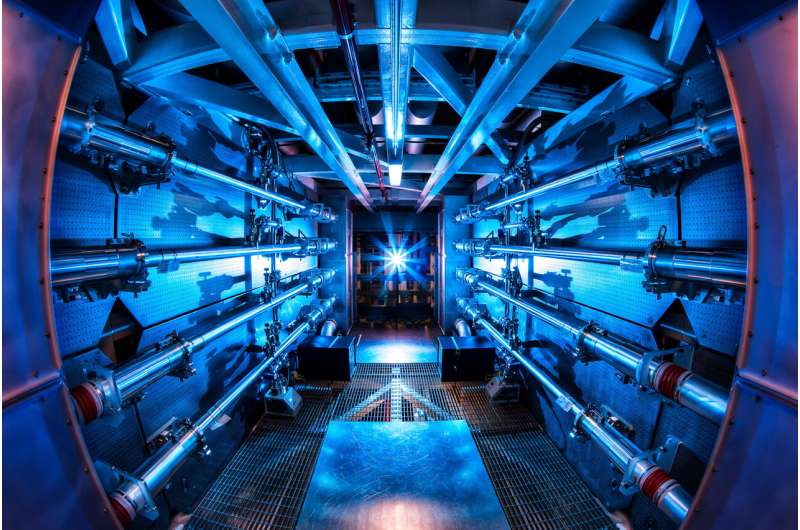February 17, 2022 feature
New studies highlight the potential of self-heating plasmas for fusion energy

Most energy-producing technologies used today are unsustainable, as they cause significant damage to our planet's natural environment. In recent years, scientists worldwide have thus been trying to devise alternative energy solutions that take advantage of abundant and natural resources.
In addition to solar energy, wind energy and seawater energy solutions, some physicists and engineers have been exploring the possibility of sourcing energy from nuclear fusion reactions. This is the process through which two atomic nuclei combine to form a heavier nucleus and an energetic neutron.
Two research teams working at the Lawrence Livermore National Laboratory's (LLNL) National Ignition Facility (NIF) demonstrated new approaches to increase nuclear energy production via a laser-driven fusion reaction. Their findings, published in recent Nature and Nature Physics papers, open new exciting possibilities for one day using self-heating plasmas as sustainable energy sources.
"The recent Nature paper and the companion paper by Annie Kritcher et al. report on the results of applying a strategy for increased fusion performance that our team constructed and presented to the inertial confinement fusion community about four years ago," Omar A. Hurricane, chief scientist of the Inertial Confinement Fusion program at LLNL, told Phys.org.

That strategy, building upon decades of previous work in inertial fusion research, called for significantly increasing the size of the fuel capsule within the fusion target, which increases the energy content in the fusion fuel and reduces the rate of cooling. This work, dubbed 'high yield big radius implosion design' (HYBRID), served as a starting point for the researchers' latest experiments.
"The work presented in Nature Physics built on this previous work, understanding, and technology, but solved a new technical challenge of initially delivering more energy to the hot plasma to generate enough fusion reactions that the fusion would eventually help reheat the plasma," Annie Kritcher, one of the lead researchers involved in the study, told Phys.org. "To do this, the size of the implosion was made larger which posed a variety of technical challenges."
While Hurricane, Kritcher and their teams at the Lawrence Livermore National Laboratory had previously demonstrated the potential of the HYBRID strategy, they also found that it had a series of limitations. Most notably, when implementing the HYBRID design, they found it difficult to maintain stability-related properties, implosion velocity and symmetry control that they attained using smaller capsule implosions, as the laser energy quickly ran out.
"As the capsule gets larger, we need more energy to drive the implosion" notes Chris Young, another lead author of the study. "Since we're already maxing out the NIF laser, we have to get creative about how to increase the efficiency of the 'hohlraum' that converts laser photons into X-rays that drive the implosion."

In their experiment, Kritcher and her team shone laser beams onto the inside of a golden can, producing an X-ray 'radiation oven.' This 'oven' was then used to heat up the outside of a capsule containing the fusion fuel and ablate the material outward, producing an inward compressive force on the fuel that ultimately causes the sample to implode under extreme pressures. Maintaining a spherically symmetric implosion is critical for obtaining good performance.
"At these high pressures, fusion reactions occur, and a product of these reactions is re-absorbed, which further heats the plasma (self-heating)," Kritcher explained. "The advancements made in this work enabled us to drive larger scale implosions which provided more initial fusion reactions and more self-heating. When the self-heating is greater than the work needed to start the fusion reactions, the plasma has started burning."
Using their unique experimental design, the two teams were ultimately able to prompt plasma to 'heat itself up.' This could ultimately help to produce larger fusion reactions, without requiring more advanced and expensive equipment.
"Obtaining a 'burning plasma' state has been a goal for the fusion research community for decades and it's a necessary step towards even higher levels of fusion performance," Hurricane explained. "Obtaining a burning plasma means we are closing in on the tipping-point of fusion ignition."

The recent work by the Lawrence Livermore National Laboratory is a huge step forward for the research community exploring nuclear fusion reactions. In addition to solving a long-standing research problem in the field, it could ultimately facilitate the introduction of alternative energy solutions based on self-heating plasmas.
"Being able to access this regime enables study of these extreme plasmas and is a critical first step in the ultimate goal of achieving ignition and high energy gains," Kritcher said. "Our future work will include improvements to the target design, to further increase the amount of initial fusion and the re-absorption of the fusion products to lead to higher gains. Finally, we will also study these new plasma systems."
In their next studies, the two teams plan to study the burning plasma state they observed more in-depth, to better understand the physics behind it. In addition, they would like to improve the robustness of their design, for instance by reducing its shot-to-shot variability.
"Inertial confinement fusion experiments at the NIF have made steady progress over a decade to investigate challenges in achieving the plasma conditions (pressures of hundreds of billions of atmospheres) required for significant fusion to occur and overcoming these challenges," Hurricane added. "We will continue pushing for higher levels of fusion performance, by building upon what we've learned so far."
More information: A. B. Zylstra et al, Burning plasma achieved in inertial fusion, Nature (2022). DOI: 10.1038/s41586-021-04281-w
A. L. Kritcher et al, Design of inertial fusion implosions reaching the burning plasma regime, Nature Physics (2022). DOI: 10.1038/s41567-021-01485-9
O A Hurricane et al, Beyond alpha-heating: driving inertially confined fusion implosions toward a burning-plasma state on the National Ignition Facility, Plasma Physics and Controlled Fusion (2018). DOI: 10.1088/1361-6587/aaed71
R. Betti et al, Alpha Heating and Burning Plasmas in Inertial Confinement Fusion, Physical Review Letters (2015). DOI: 10.1103/PhysRevLett.114.255003
Journal information: Nature Physics , Nature , Physical Review Letters
© 2022 Science X Network





















